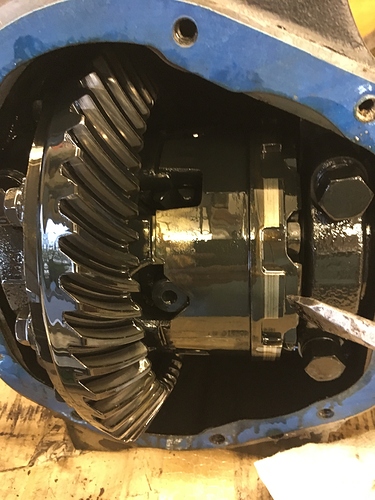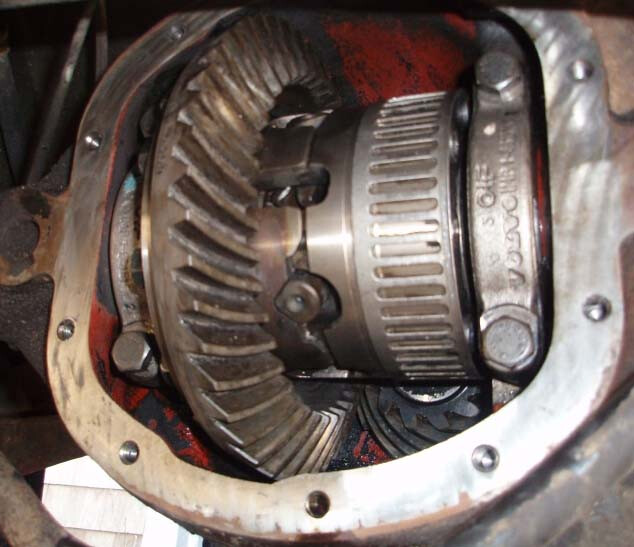I couldn’t find the thread, but awhile back there was some discussion about what exactly inside the rear diff triggers the speedometer sensor (on cars equipped with the diff-mounted sensor.). Here’s the answer. Newer diff (89 xjs) has a machined surface that lines up with the sensor. Older diff (red, 69 E type) does not. These are both Salisbury diffs. I’m installing the red one b/c it has the 3.54 ratio I want for my manual conversion. I’ll likely convert my speedo to gps.
Bob
Y’know, you could fake that pickup. Fashion a piece of sheet metal to replace one of the shims between the output shaft flange and the inner U-joint on one side. At the OD of this critter, cut a series of teeth, making sure it’s the same number of teeth as on that carrier on the inside. Then fab up a bracket to hold the OEM pickup near those teeth.
Interesting. I had not thought of doing it externally. If you could get it to turn true enough you could drill however many evenly spaced holes in the sheet metal ujoint shroud. The “bars” between the holes might trigger the pickup.
The uni shroud might move about too much for the sensor. Kirby’s idea is on the “solid” side of the joint so no moving with suspension. Air gaps are normally pretty sensitive.
Now you have me wondering … so if the fluid level in the differential in Superblue IS low, would that also account for the intermittent speedo needle “quiver” under 50 MPH or so? 
I kinda thought a few analogous images from across the web would be interesting, but not jag images.
There seem to be several strategies for applying a VR sensor to the diff.
Mostly Variants of this:
And then there are external setups:
~Paul K.
Aren’t there a lot of 1993 & later XJS (& maybe compatible XJ) 3.54 differentials around (in “recycle Yards” - rebuild if necessary)with the speed sensor on the back cover??
How about the interchange ability between the internal parts - for example take a compatible speed sensor type spool and bolt your 3.54 ring gear to it? Of course you would have to set up the diff. again to get the correct tooth pattern.
AFAIK all salisbury guts are interchangable. In fact, as long as EVERYTHING is swapped, salisbury guts can go into Dana diffs and vice versa as well. You just can’t mix and match with Dana guts. Salisbury guts can be mixed and matched. (Carriers w/ ring & pinions I mean)
~Paul K.
Yes this is possible and frankly the best answer as the later diffs seems to be a superior design at least in terms of output shaft bearings and the way the brakes attach (no separate brackets required.) (Yes just the output shafts can be interchanged.) Long sad story, but here is the last page:
- We tried no less than 5 “experts” during a diff swap in the e-type. Some of these are big shops that you’ve heard of. Others were local pros. The results each time were a noisy, annoying diff. Yes, we had the rear suspension and diff in and out 5 times. So, when I got the opportunity to purchase a “known good” 3.54 that I could drop in to the XJS, I took it.
- We since found Dick Maury, who is a diff genius and the only person on planet earth I would have work on my Jaguar diff. But by that time I had already put the “old” new diff in the XJS. I will be sending him the original XJS diff for conversion to 3.54 at some point.
- The 3.54 that Mr. Maury built for our e-type is dead silent and super smooth. As it should be.
Regards
Bob
Dick is an Amazing guy. He was once one @ Coventry West, the largest Jag diff rebuilder in the USA at least. I remember when his eType club racer was in construction there. CW had purchased every last discarded diff from Jaguar UK. Apparently when they warranty swapped them out they literally chucked the old ones into a field out back of the factory. CW had what looked like thousands filling cage-bins stacked very high in their warehouse. They’d tag all the parts so that nothing got swapped and original sets of items moved through the process together.
~Paul K.
OK, so what is the difference? Rebuilding a diff is theoretically a fairly straightforward process, right down to marking the gear teeth to ensure the mesh is correct. Is there a difference in the quality of the gears themselves? If so, how do you get the good gears rather than the noisy ones?
Just my experience and observations:
- I’ve been told by several knowledgeable people that there is no such thing as “good” (that is, quiet) Dana gears these days. The new gears (mostly made for Jeeps) are just noisy no matter how good the set up. Apparently best to get “good” used Jaguar gears. My Jeep buddies do their own and seemingly have no issues, but I can’t hear the diff over the transmission, exhaust, wind and knobby tires
 so I really have no comparison there.
so I really have no comparison there. - The setup only works if you take time to do it right and have the tools, (e.g. bearings that are slightly oversized so they don’t have to be repeatedly pressed on and off when checking shims), and you know what a good pattern looks like, etc. Upon inspecting a couple of our “professionally” rebuilt diffs we found damaged bearings, shims that were half way hanging out, and crappy patterns. No surprise they were noisy.
We thought that this was one area that was best left to “professionals” but in hindsight, pre-finding Mr. Maury, we likely could have done a better job ourselves had we invested the time to learn. Shockingly, like many Jaguar “mechanics”, these “professionals” weren’t.
There’s something to be said for experience, I imagine Mr. Maury has done few diffs, so it stands to reason that someone with that experience knows a few tricks that are not in the shop manual.
So, what makes gears noisy? I’m gonna guess surface finish on the tooth faces. I’m also gonna guess there’s nothing that can be done about it, you can’t hand-polish them or anything.
Would surface imperfections wear-in over time? Otherwise I guess it would be a small misalignment of the angled surfaces. Ensuring proper seating for the bearings should mitigate that problem. I’ve replaced the output and propshaft bearings on my diff and not noticed any additional noise. But I do have only one silencer box in each side of the exhaust system, so “noisy” is a very relative term. Just turn the radio up.
Waaay back in the day my parents owned a 1977 Dodge van they bought new, drove 100+K miles, replaced the engine, drove another 50K, finally sold it. Somewhere in there the diff got noisy. They took it to some mechanic and got an estimate for some serious money to rebuild it. They called me to ask if the estimate was reasonable, and I said yes it was, but did they really wanna spend it? AFAIK, the diff rarely fails and leaves you stranded on the road. The only good reason for a rebuild is to get rid of that noise, and the van was already a noisy POS anyway. They agreed, no problem with the noise, and drove it several more years and sold it with that diff still making that droning sound – which, interestingly, never seemed to get any worse.
I think it is generally true that diffs get more noisy with wear. Do others agree? Because offhand it would seem wear would make them quieter IF the noise is caused by surface finish on the tooth faces. So what wears that makes them noisy? The bearings? You can tell bearings from gears by whether the noise disappears when coasting, which it did on the Dodge, indicating it was the gears.
Generally, bearing noises get worse with wear; what complicates the situation is that differential bearings lose their preload as they wear. This in turn changes the gearset contact, which then causes the gear surface to wear.
The Dodge van noise was probably an axle shaft bearing that isn’t preloaded; the Chrysler corporate 8.25 axle had roller axleshaft bearings that had no inner race, rollers rode directly on the axle surface.
If the noise was less on coast, could be loss of pinion bearing preload. Axleshaft bearing noise would be consistent, but generally wouldn’t get worse.
My ‘88 Salisbury differential had a pinion seal replaced prior to me. I resealed the stub shafts (with new collapsible spacers) and replaced the pinion seal (again with a new collapsible spacer, because bearings lost their preload) and the gearset was worn badly as a result. Didn’t have a gearset in the budget, so I am living with the noise.
Agree completely. The 8.25 rear end in my Cherokee became noisy, so I tore it apart about a month ago and replaced diff. carrier bearings (One was badly worn) and axle bearings and seals. Luckily I still had the pipe with a big nut welded on the end from years ago to torque the preload on the carrier bearings and set the lash. No more noise.
OK, refresh my memory: Is it possible to adjust the pinion bearing preload without completely rebuilding the diff and without mucking up the gear mesh? I recall well that when replacing the pinion seal, you’re supposed to mark the orientation of the nut and only retighten to the same place.
Changing the front seal and changing the preload will not effect the gear mesh. Gear mesh is controlled by the shims positioning the pinion gear and the carrier. The early diffs (pre~68) used shims to set the pinion bearing preload. You can just zip off the nut and then zip it back on afterwards. With the crush sleeve, it is a different story. Preload is set on new bearings, not run in ones. The crush sleeve is also supposed to be a one time use piece. Taking the load off of it to change the front seal and then putting it back will not have the same tension as the first time. That said, it is very important to mark the nut to install back where it was exactly. Most of the time, this works.



